Lifespan (Half-Life) of Social Media Posts: Update for 2024
Lifespan (Half-Life) of Social Media Posts: Update for 2024
01 January 2024
BY SCOTT M. GRAFFIUS | ScottGraffius.com
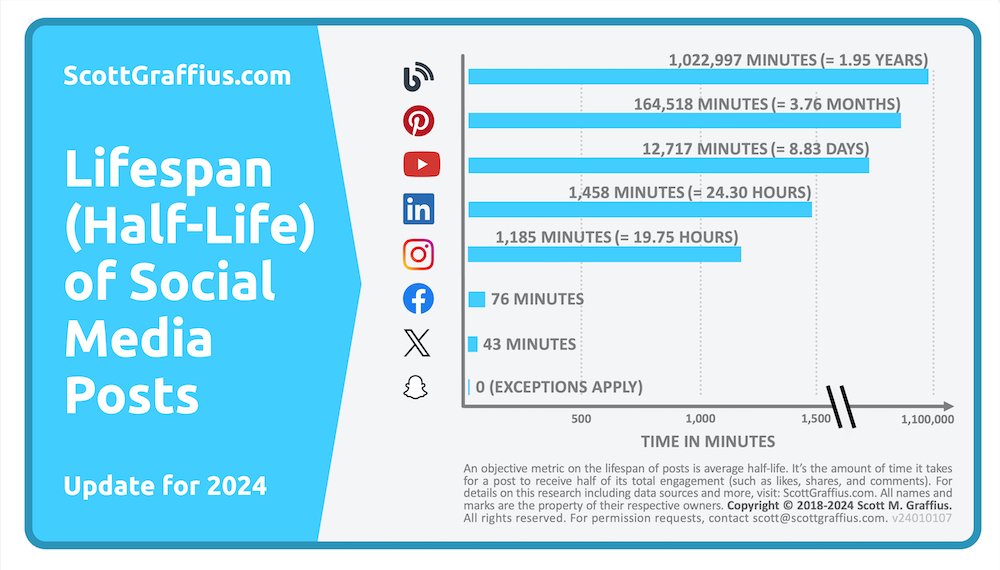

If there are any supplements or updates to this article after the date of publication, they will appear in the Post-Publication Notes section at the end of this article.


Introduction
Individuals and businesses use the Internet and other forms of digital communication to reach and engage target audiences and promote content. That’s digital marketing. It includes email, social media, web-based advertising, and text and multimedia messages.
A rapidly expanding component of digital marketing is social media marketing. It involves posting content on social media platforms such as Snapchat, X (formerly known as Twitter), Facebook, Instagram, LinkedIn, YouTube, Pinterest, and blogs. The platforms enable people to connect with family and friends, share information and ideas, and access news and entertainment. The platforms also play a vital role in business by providing companies with direct channels to reach and engage with their target audiences. When well-executed, social media marketing delivers multiple benefits, including:
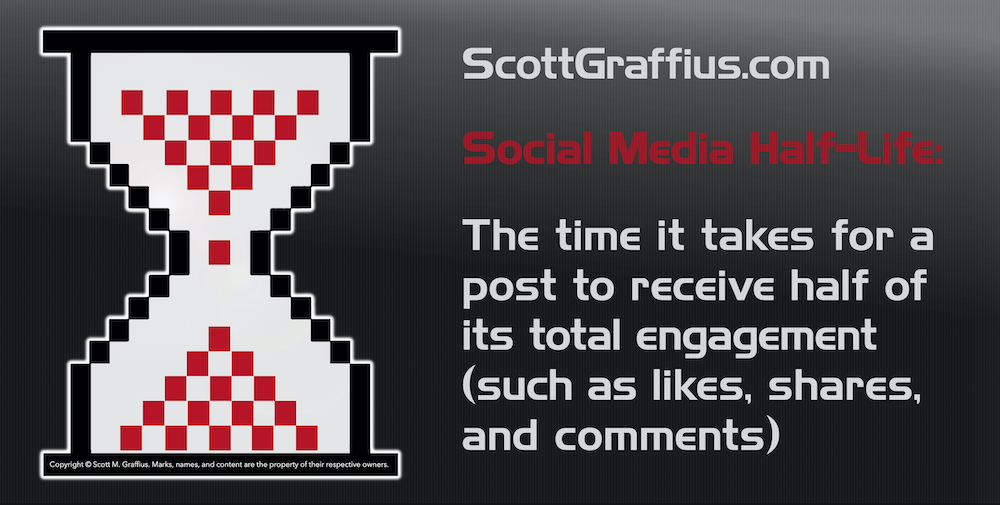
When content is published online, relevance and engagement have a limited lifespan. An advantageous objective metric is half-life. It’s the time it takes for a post to receive half of its total engagement (such as likes, shares, and comments). Data can help inform strategic and tactical decisions, such as the frequency and scheduling of posts.
In 2018, Scott M. Graffius first published data on the lifespan (half-life) of social media posts. Algorithms and other factors on platforms change over time.B2 For that reason, Graffius periodically updates the analysis. This article provides the update for 2024.
Reports by others on the shelf life of social media are often based on the experience of one person, one organization, or one limited set of data. With any of those common limitations, findings are at risk of being non-representative, inaccurate, or unreliable.
It’s important to have a broad set of data from multiple sources. In addition to generating results that are more likely to be appropriately representative, accurate, and reliable, this approach provides a more complete picture and helps identify trends. Graffius’ “Lifespan (Half-Life) of Social Media Posts: Update for 2024” — this research report — is built on data from 37 sources.A
Based on an analysis of data from 37 diverse sources,A this report reveals the average lifespan (half-life) for posts on Snapchat, X, Facebook, Instagram, LinkedIn, YouTube, Pinterest, and blogs.


Main Section of Article
As detailed next, the half-life of posts varies by social media platform.


Snapchat
Snapchat is a multimedia instant messaging app and service developed by Snap Inc., originally Snapchat Inc. A distinguishing feature of the platform is that pictures and messages are usually only available for a short time before they become inaccessible to their recipients. Snapchat has 750,000,000 (750 million) active users.B3
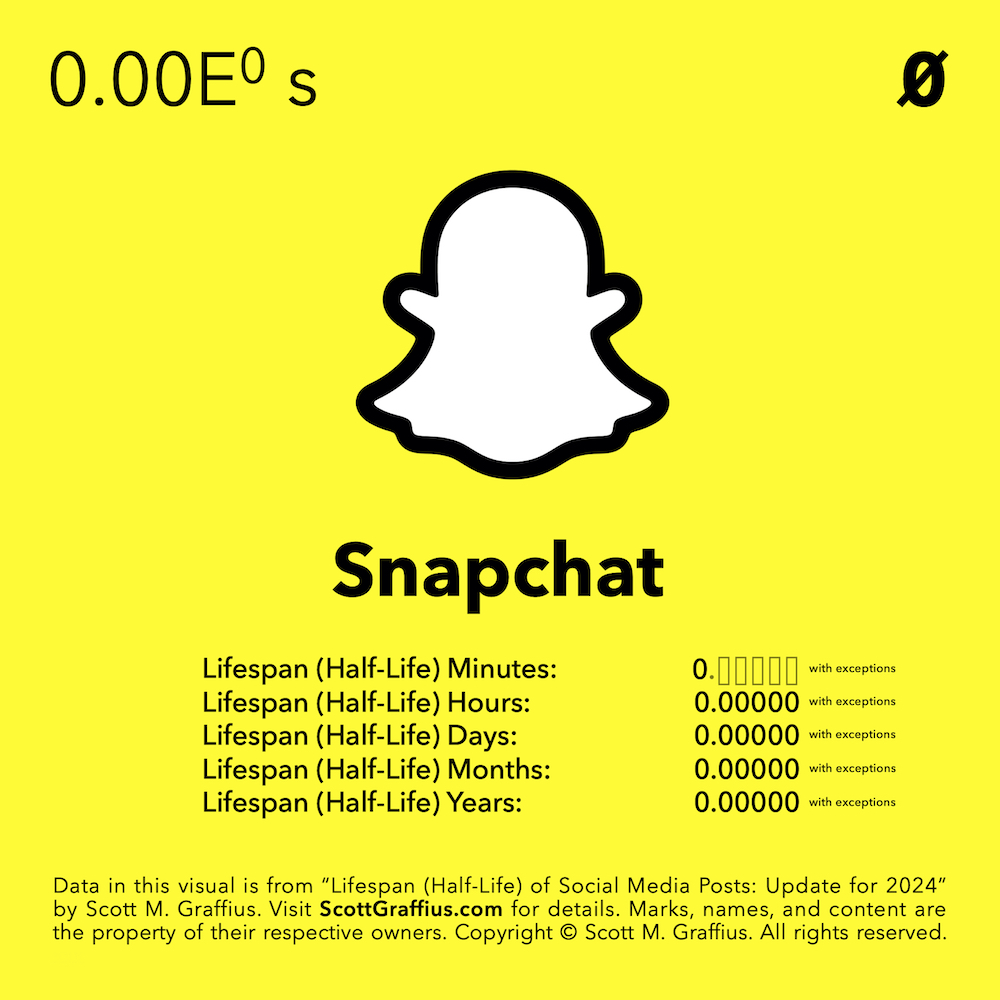
The average half-life duration for Snapchat posts is 0 minutes.A Exceptions apply. Snapchat messages may disappear instantly or live up to 24 hours (even longer in certain cases) depending on the type of message, user settings, and other details.
Algorithms and other factors on platforms can change over time, potentially impacting the average half-life duration for posts. For comparison, here’s data on Snapchat for 2024 along with the last two annual editions of this report:


X
X (formerly known as Twitter) is a microblogging and social networking service owned by X Holdings II, Inc. (a wholly owned subsidiary of X Holdings I, Inc., wholly owned by Elon Musk), on which users post and interact with messages known as "tweets". X has 666,000,000 (666 million) active users.B3 (Note: The data source is held in high regard. Some other organizations report a lower value.)
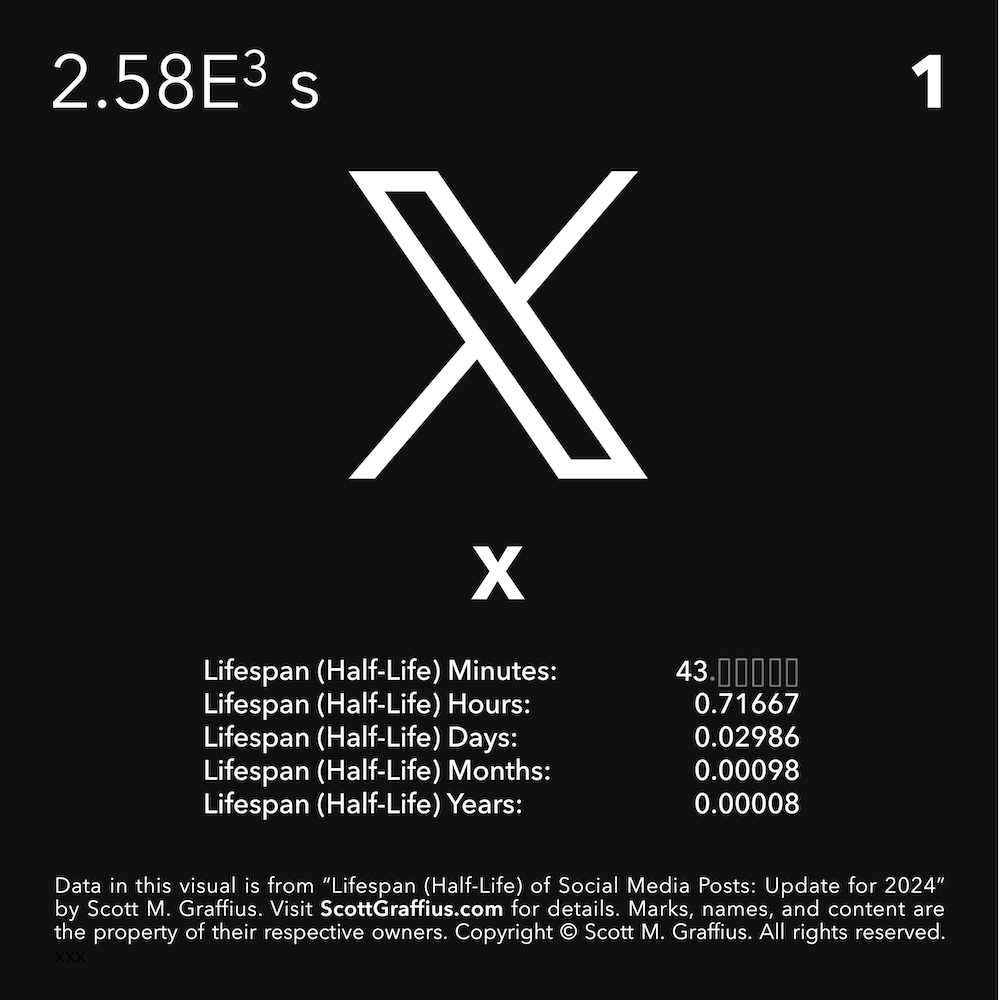
The average half-life duration for tweets is 43 minutes.A
Algorithms and other factors on platforms can change over time, potentially impacting the average half-life duration for posts. For comparison, here’s data on Twitter for 2024 along with the last two annual editions of this report:


Facebook
Facebook is an online social media and social networking service owned by Meta Platforms. It's the third most visited website in the world. Facebook has 3,030,000,000 (3.03 billion) active users.B3
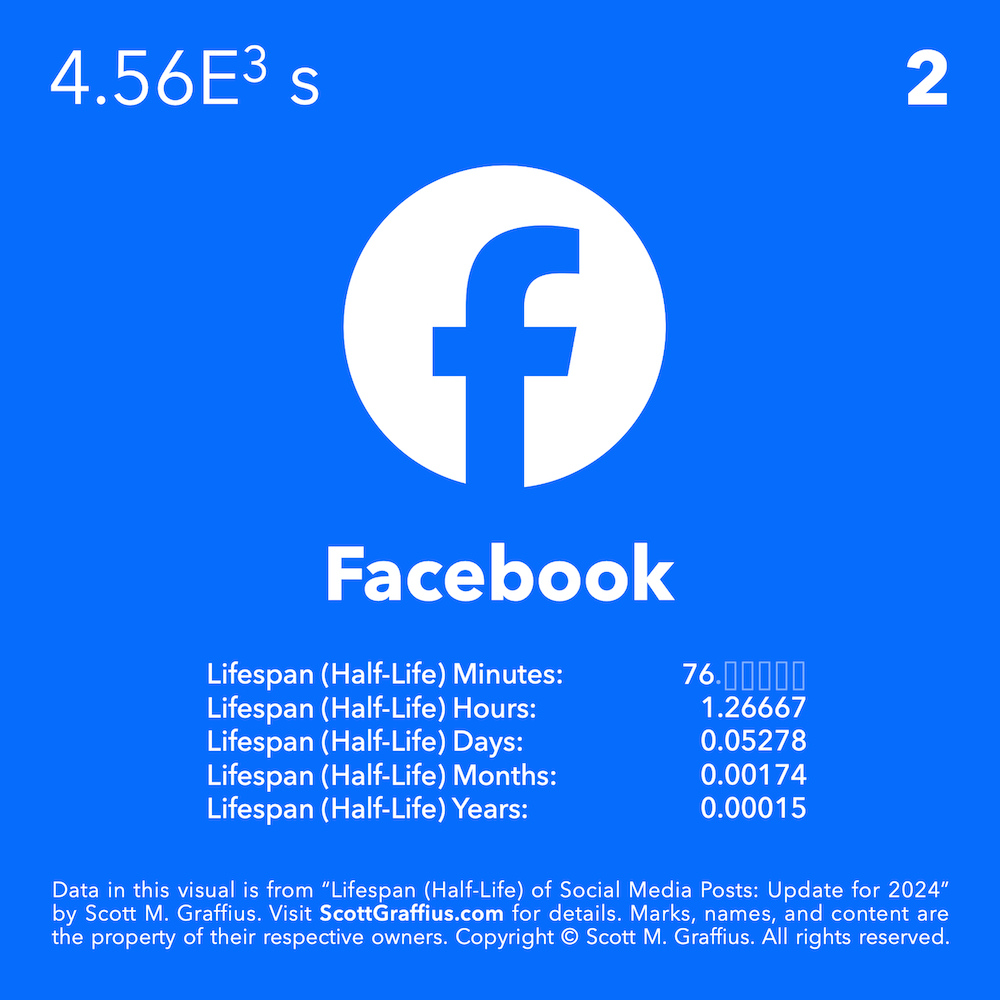
The average half-life duration for Facebook posts is 76 minutes (= 1.27 hours).A
Algorithms and other factors on platforms can change over time, potentially impacting the average half-life duration for posts. For comparison, here’s data on Facebook for 2024 along with the last two annual editions of this report:


Instagram
Instagram is a photo and video-sharing service owned by Meta Platforms. The service allows users to upload media that can be edited with filters and organized by hashtags and geographical tagging. Users can browse other users’ content by tag and location, view trending content, like photos, and follow other users to add their content to a personal feed. Instagram has 2,000,000,000 (2.00 billion) active users.B3
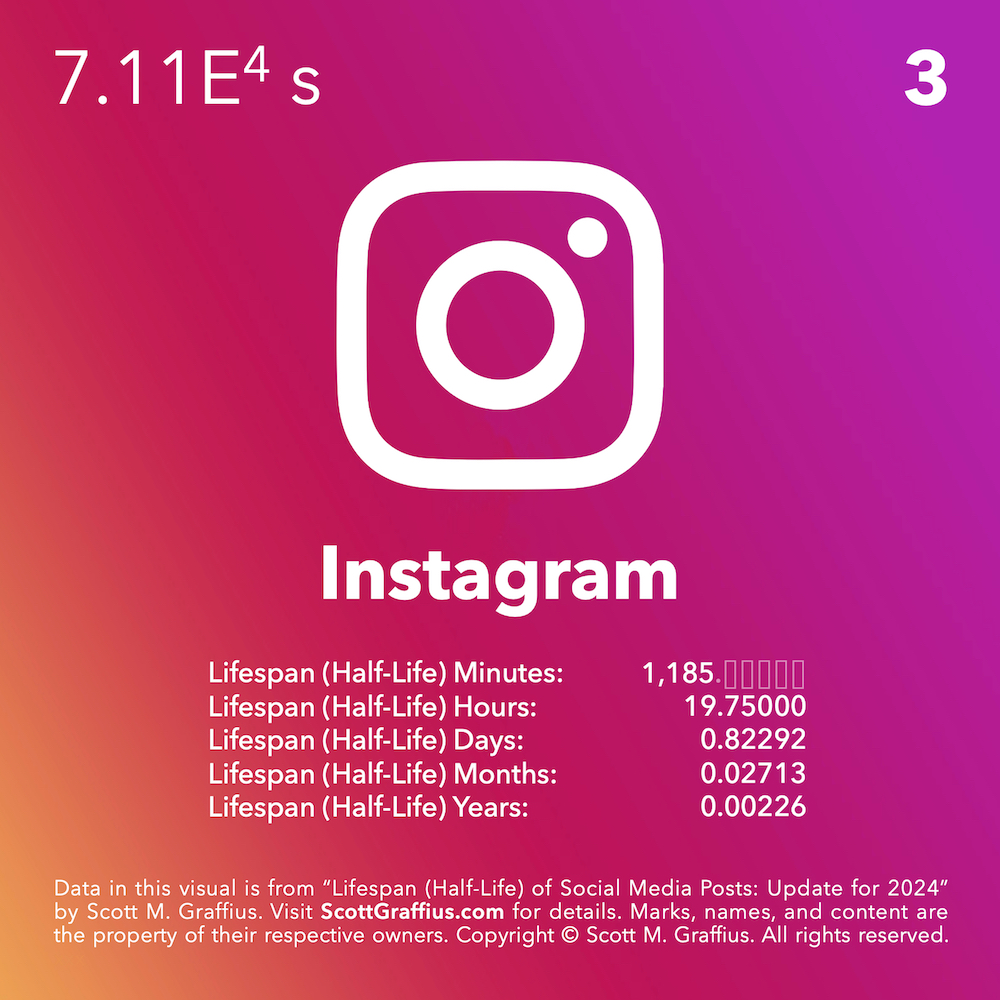
The average half-life duration for Instagram posts is 1,185 minutes (= 19.75 hours).A
Algorithms and other factors on platforms can change over time, potentially impacting the average half-life duration for posts. For comparison, here’s data on Instagram for 2024 along with the last two annual editions of this report:


LinkedIn
LinkedIn is a business and employment-oriented online service. It's a wholly-owned subsidiary of Microsoft. LinkedIn claims to have 875,000,000+ (875 million) users.B6 However, it does not report how many of those users are active users. It’s estimated that 424,000,000 (424 million) are active users.B7
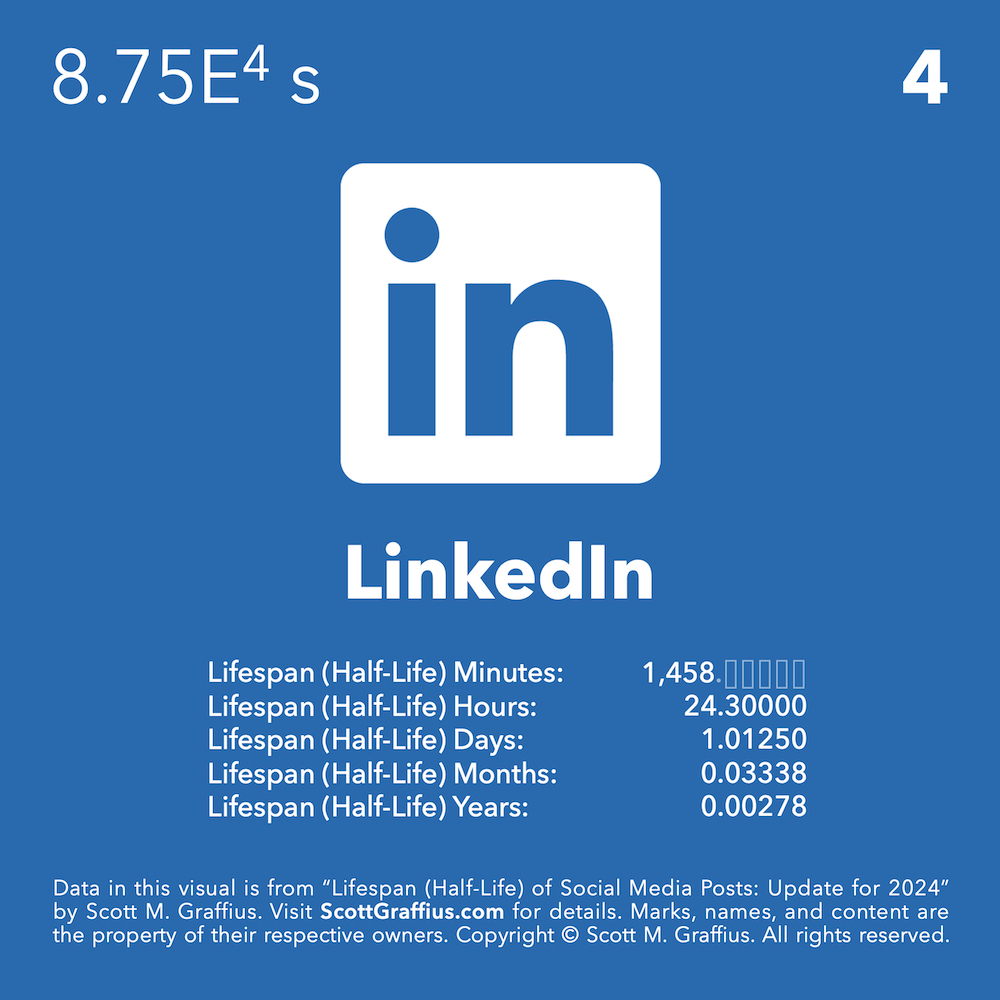
The average half-life duration for LinkedIn posts is 1,458 minutes (= 24.30 hours).A
Algorithms and other factors on platforms can change over time, potentially impacting the average half-life duration for posts. For comparison, here’s data on LinkedIn for 2024 along with the last two annual editions of this report:


YouTube
YouTube is an online video-sharing platform. It's owned by Google, and it's the second most visited website, after Google Search. YouTube has 2,490,000,000 (2.49 billion) active users.B3
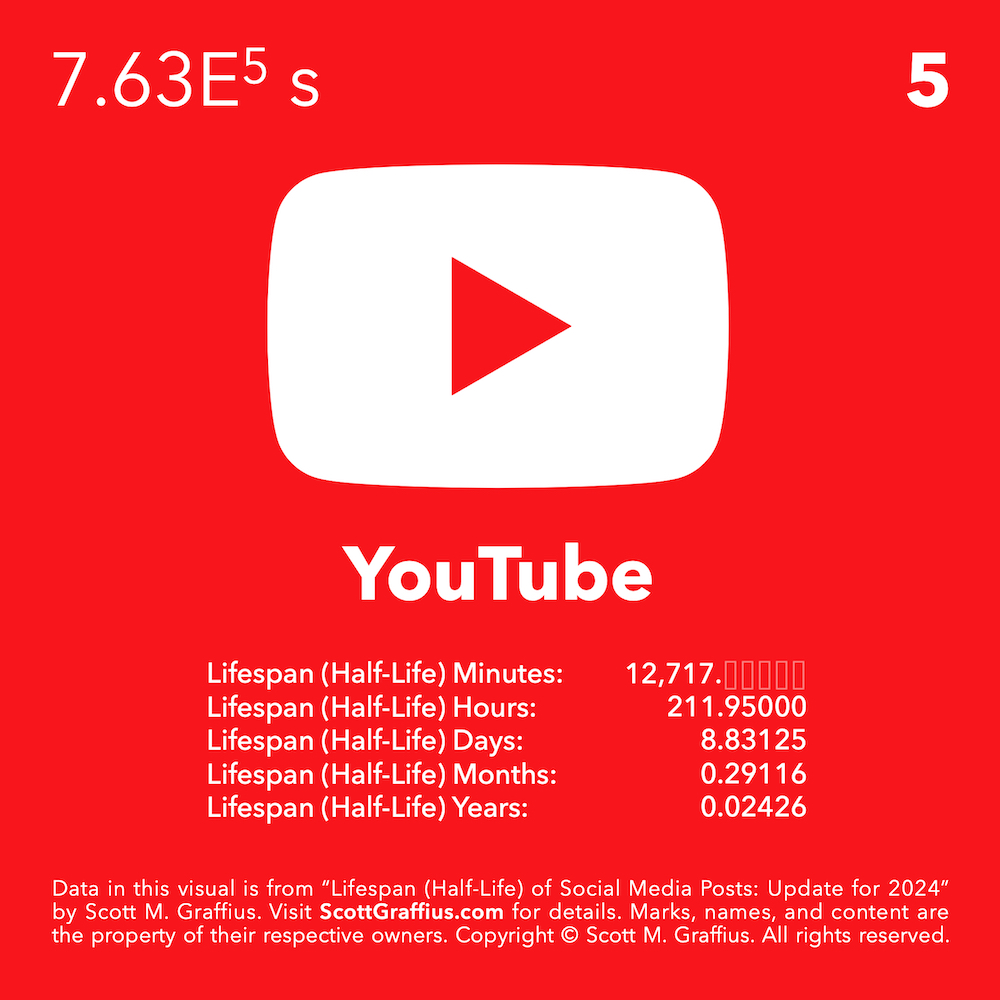
The average half-life duration for YouTube posts is 12,717 minutes (= 8.83 days).A
Algorithms and other factors on platforms can change over time, potentially impacting the average half-life duration for posts. For comparison, here’s data on YouTube for 2024 along with the last two annual editions of this report:


Pinterest
Pinterest is an image-sharing service designed to enable the saving and discovery of information (specifically "ideas") on the internet using images — and on a smaller scale, videos — in the form of pinboards. The platform is operated by Pinterest, Inc. It has 465,000,000 (465 million) active users.B3
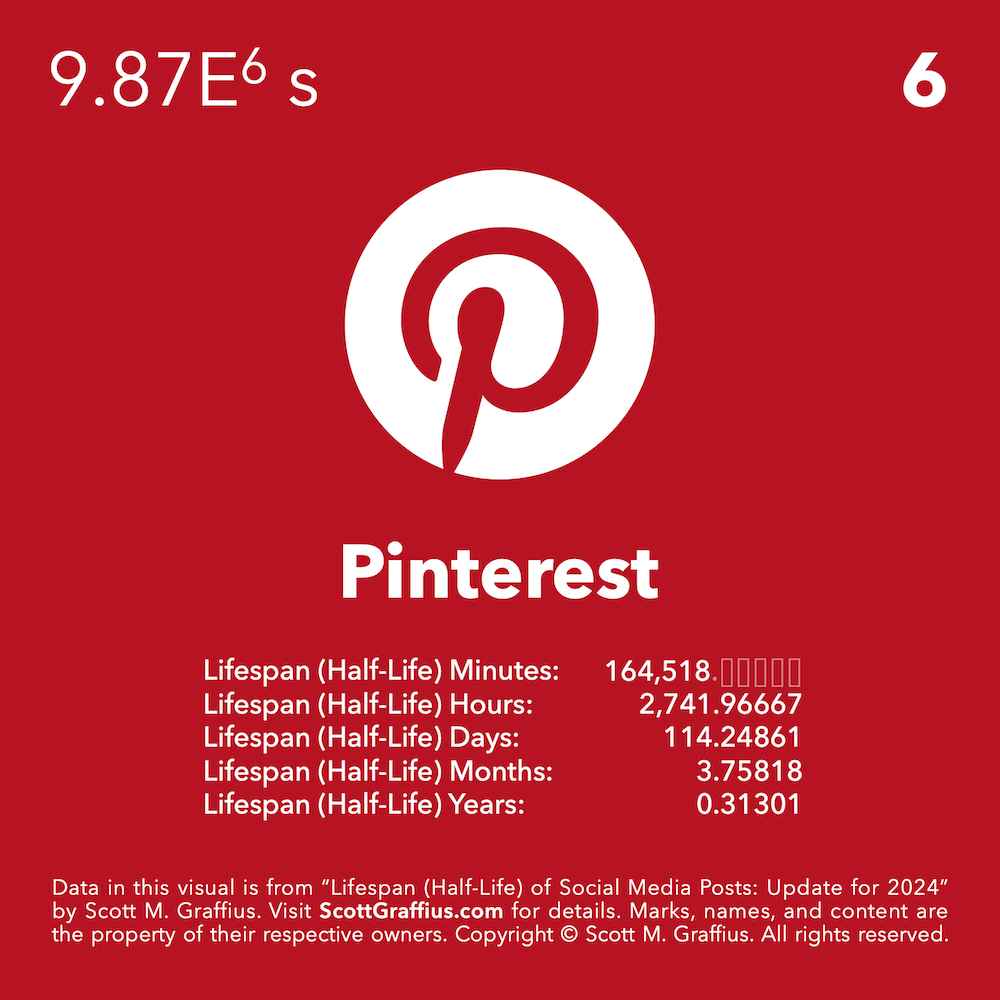
The average half-life duration for Pinterest posts is 164,518 minutes (= 3.76 months).A
Algorithms and other factors on platforms can change over time, potentially impacting the average half-life duration for posts. For comparison, here’s data on Pinterest for 2024 along with the last two annual editions of this report:

Blogs
Blogs (a truncation of "weblogs") are discussion or informational websites consisting of discrete, often diary-style entries. Up until 2009, blogs were usually the work of individuals and each typically covered a single topic. In the 2010s, multi-author blogs (MABs) from media outlets and others emerged. In addition to featuring the writings of multiple authors, MABs often span a range of topics. It is estimated that there are over 600,000,000 (600 million) blogs.B8
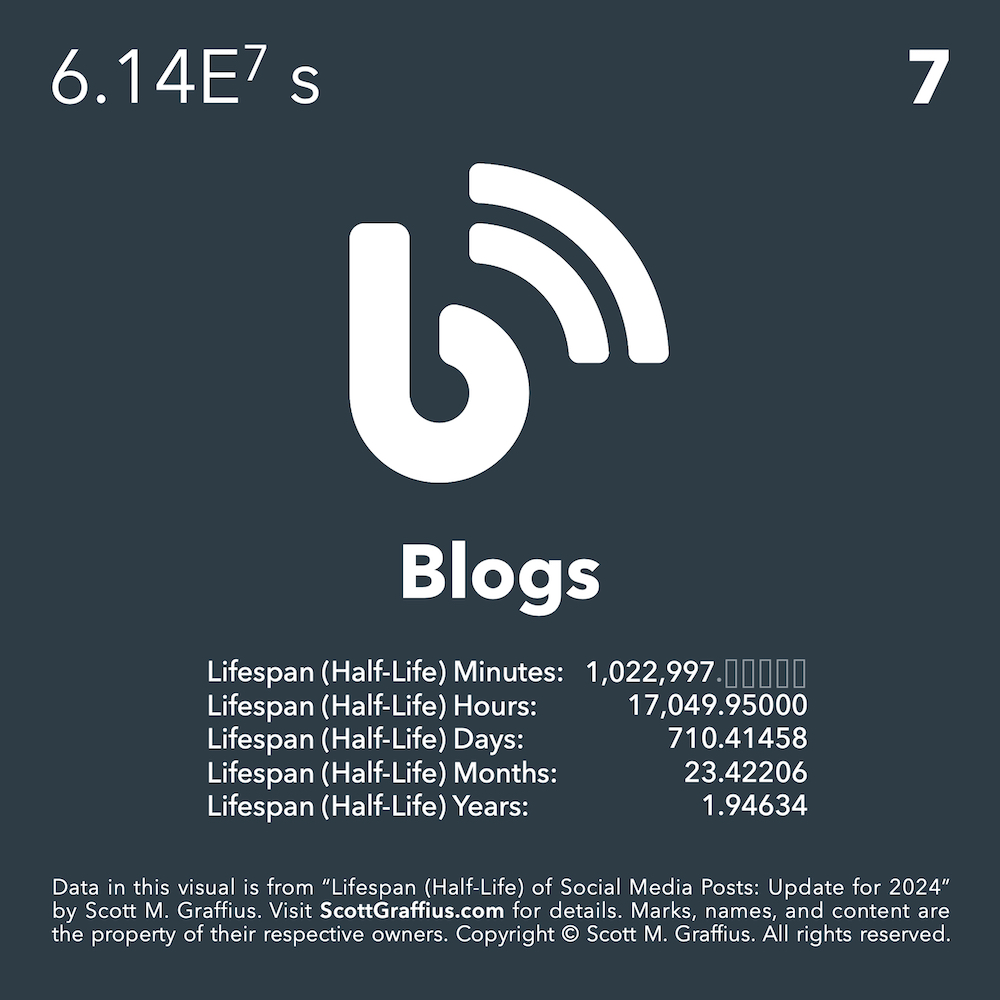
The average half-life duration for blog posts is 1,022,997 minutes (= 1.95 years).A
The functionality of blogs and other factors can change over time, potentially impacting the average half-life duration for posts. For comparison, here’s data on blogs for 2024 along with the prior annual edition of this report (note: this research started reporting on blogs in 2023):


Conclusion
Social media platforms — such as Snapchat, X, Facebook, Instagram, LinkedIn, YouTube, Pinterest, and blogs — enable people to connect with family and friends, share information and ideas, and access news and entertainment. The platforms also provide organizations with direct channels to reach and engage with their target audiences.
The relevance and engagement of posts on social media platforms have a limited lifespan. An advantageous objective metric is half-life. It’s the time it takes for a post to receive half of its total engagement (such as likes, shares, and comments). In 2018, Scott M. Graffius first published data on the lifespan (half-life) of social media posts. Algorithms and other factors on platforms change over time. For that reason, Graffius periodically updates the analysis. This report, which is based on half-life data from 37 sources, provides an update for 2024.
Social media analytics provide valuable insights that can support efforts to level-up engagement and results.B9,B10,B11,B12,B13,B14,B15 Data on the average lifespan (half-life) of posts, for example, can help inform strategic and tactical decisions such as the frequency and scheduling of posts.


Graffius’ Research is Widely Cited
Scientists, researchers, journalists, academics, YouTubers, podcasters, SEO experts, analysts, businesses, and others have featured and used prior — 2023 and earlier — editions of Scott M. Graffius’ “Lifespan (Half-Life) of Social Media Posts” research. Here are a few examples:
Graffius appreciates the coverage of his research.


References/Sources
References/sources are organized into two sections - A and B.
A. Here are the sources related to the lifespan (half-life) of social media posts:
B. Here are the references for additional information (such as the number of active users on platforms, etc.; see section A for sources related to the half-life of posts):


How to Cite this Article
Graffius, Scott M. (2024, January 1). Lifespan (Half-Life) of Social Media Posts: Update for 2024. Available at: https://scottgraffius.com/blog/files/social-24.html. DOI: 10.13140/RG.2.2.21043.60965.


Permission Request Information
To request permission to use the “Lifespan (Half-Life) of Social Media Posts: Update for 2024” visual shown at the top of this article or any other material from this publication, contact Scott M. Graffius. If your request is approved, Graffius will give you an authorization/license and, if applicable, high-resolution files of the visual.

About Scott M. Graffius
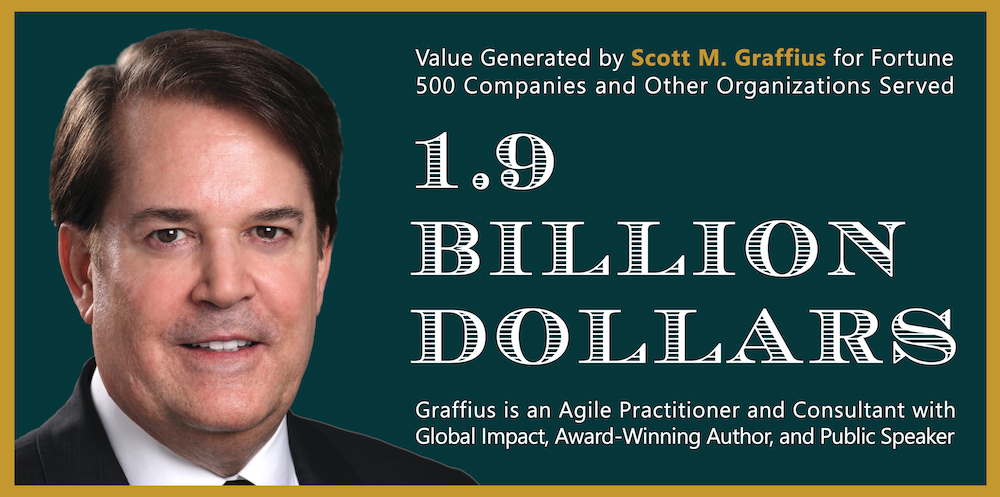
Scott M. Graffius, PMP, SA, CSP-SM, CSP-PO, CSM, CSPO, SFE, ITIL, LSSGB is an agile project management practitioner, consultant, thinker, creator, multi-award-winning author, and international public speaker. Founder and CEO of Exceptional PPM and PMO Solutions™ and subsidiary Exceptional Agility™, he has generated over $1.9 billion for Global Fortune 500 businesses and other organizations he has served. Graffius and content from his books, talks, workshops, and more have been featured and used by Microsoft, Oracle, Broadcom, Cisco, Gartner, Project Management Institute, IEEE, National Academy of Sciences, United States Department of Energy, Yale University, Tufts University, and others. He delights audiences with dynamic and engaging talks and workshops on agile project management, AI, Tech leadership, video game development, strategic alignment, the science of high performance teams, and more. To date, he's presented sessions at 89 conferences and other events across 25 countries.
His full bio is available here.
Connect with Scott on:
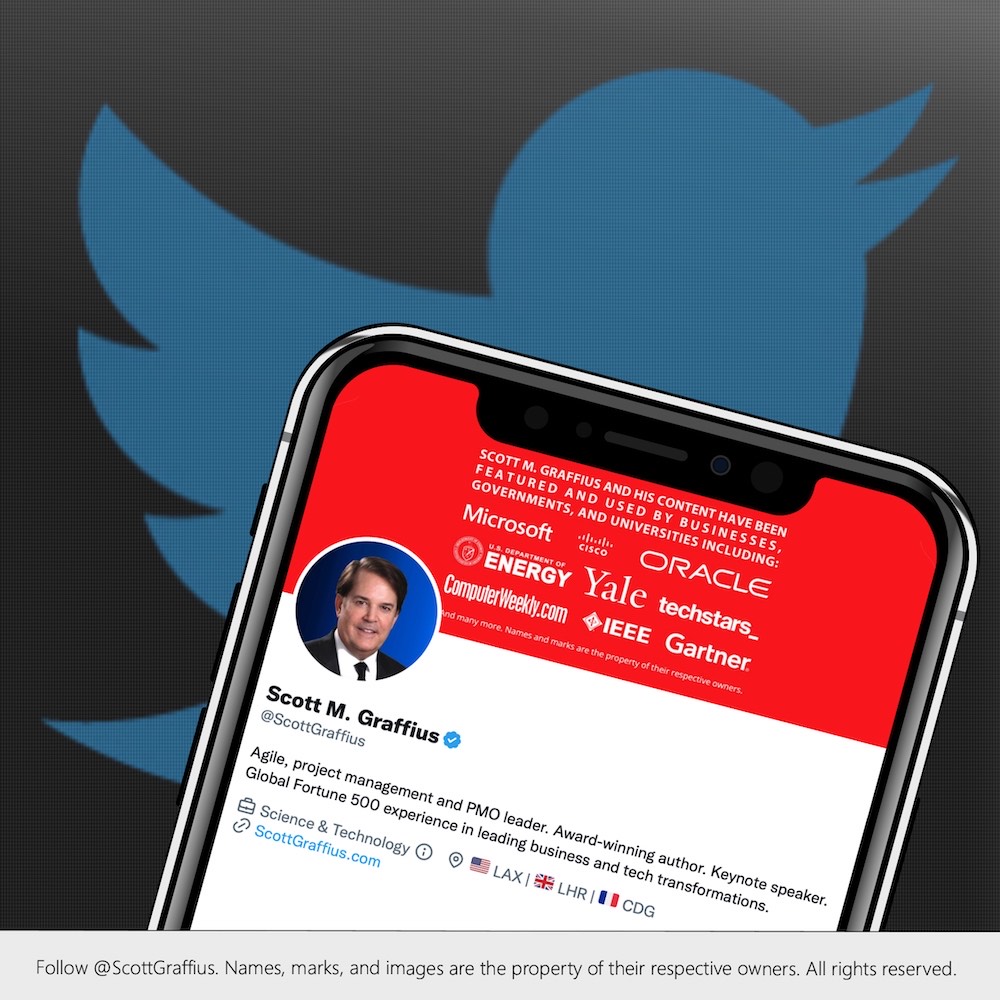
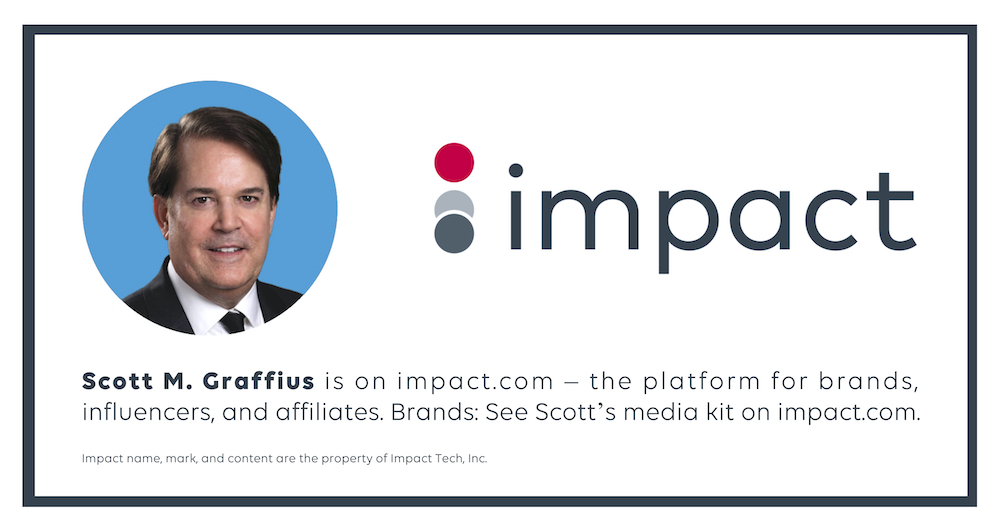

About Agile Scrum: Your Quick Start Guide with Step-by-Step Instructions
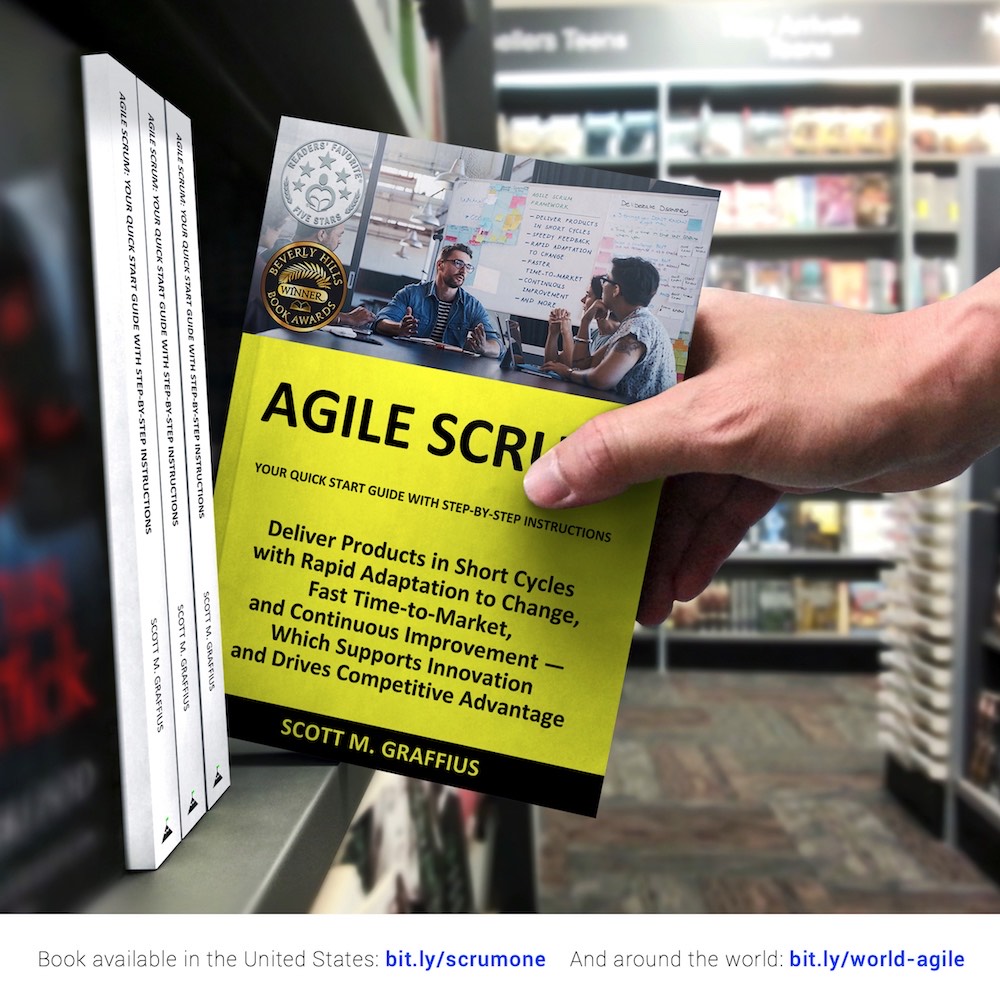
Shifting customer needs are common in today's marketplace. Businesses must be adaptive and responsive to change while delivering an exceptional customer experience to be competitive.
There are a variety of frameworks supporting the development of products and services, and most approaches fall into one of two broad categories: traditional or agile. Traditional practices such as waterfall engage sequential development, while agile involves iterative and incremental deliverables. Organizations are increasingly embracing agile to manage projects, and best meet their business needs of rapid response to change, fast delivery speed, and more.
With clear and easy to follow instructions, the multi award-winning Agile Scrum: Your Quick Start Guide with Step-by-Step Instructions book by Scott M. Graffius (Chris Hare and Colin Giffen, Technical Editors) helps the reader:
Hailed by Literary Titan as “the book highlights the versatility of Scrum beautifully.”
Winner of 17 first place awards.
Agile Scrum: Your Quick Start Guide with Step-by-Step Instructions is available in paperback and ebook/Kindle in the United States and around the world. Some links by country follow.

About Agile Transformation: A Brief Story of How an Entertainment Company Developed New Capabilities and Unlocked Business Agility to Thrive in an Era of Rapid Change

Thriving in today's marketplace frequently depends on making a transformation to become more agile. Those successful in the transition enjoy faster delivery speed and ROI, higher satisfaction, continuous improvement, and additional benefits.
Based on actual events, Agile Transformation: A Brief Story of How an Entertainment Company Developed New Capabilities and Unlocked Business Agility to Thrive in an Era of Rapid Change provides a quick (60-90 minute) read about a successful agile transformation at a multinational entertainment and media company, told from the author's perspective as an agile coach.
The award-winning book by Scott M. Graffius is available in paperback and ebook/Kindle in the United States and around the world. Some links by country follow.

The short link for this article is: https://bit.ly/life-2024


Post-Publication Notes
Update on 25 March 2024
At the time of publication, a graphic on the average lifespan (half-life) of posts on X indicated “7.71667” under hours. That typo was corrected to read “0.71667.” The change was implemented in this article on 25 March 2024.
Update on 6 January 2025
Algorithms and other factors on social media platforms change over time. For that reason, Scott M. Graffius periodically updates his 'Lifespan (Half-Life) of Social Media Posts' research. The most current edition is here.

© Copyright 2024 Scott M. Graffius. All rights reserved. This material may not be published, broadcast, rewritten or redistributed without the express written permission of Scott M. Graffius.



If there are any supplements or updates to this article after the date of publication, they will appear in the Post-Publication Notes section at the end of this article.


Introduction
Individuals and businesses use the Internet and other forms of digital communication to reach and engage target audiences and promote content. That’s digital marketing. It includes email, social media, web-based advertising, and text and multimedia messages.
A rapidly expanding component of digital marketing is social media marketing. It involves posting content on social media platforms such as Snapchat, X (formerly known as Twitter), Facebook, Instagram, LinkedIn, YouTube, Pinterest, and blogs. The platforms enable people to connect with family and friends, share information and ideas, and access news and entertainment. The platforms also play a vital role in business by providing companies with direct channels to reach and engage with their target audiences. When well-executed, social media marketing delivers multiple benefits, including:
- Engagement with a global audience — there are 4,950,000,000 (4.95 billion) active social media users worldwide.B1
- Improved brand and marketplace awareness and reach.
- Enhanced customer engagement.
- Increased website traffic.
- Improved search engine rankings.
- And more.

When content is published online, relevance and engagement have a limited lifespan. An advantageous objective metric is half-life. It’s the time it takes for a post to receive half of its total engagement (such as likes, shares, and comments). Data can help inform strategic and tactical decisions, such as the frequency and scheduling of posts.
In 2018, Scott M. Graffius first published data on the lifespan (half-life) of social media posts. Algorithms and other factors on platforms change over time.B2 For that reason, Graffius periodically updates the analysis. This article provides the update for 2024.
Reports by others on the shelf life of social media are often based on the experience of one person, one organization, or one limited set of data. With any of those common limitations, findings are at risk of being non-representative, inaccurate, or unreliable.
It’s important to have a broad set of data from multiple sources. In addition to generating results that are more likely to be appropriately representative, accurate, and reliable, this approach provides a more complete picture and helps identify trends. Graffius’ “Lifespan (Half-Life) of Social Media Posts: Update for 2024” — this research report — is built on data from 37 sources.A
Based on an analysis of data from 37 diverse sources,A this report reveals the average lifespan (half-life) for posts on Snapchat, X, Facebook, Instagram, LinkedIn, YouTube, Pinterest, and blogs.


Main Section of Article
As detailed next, the half-life of posts varies by social media platform.


Snapchat
Snapchat is a multimedia instant messaging app and service developed by Snap Inc., originally Snapchat Inc. A distinguishing feature of the platform is that pictures and messages are usually only available for a short time before they become inaccessible to their recipients. Snapchat has 750,000,000 (750 million) active users.B3

The average half-life duration for Snapchat posts is 0 minutes.A Exceptions apply. Snapchat messages may disappear instantly or live up to 24 hours (even longer in certain cases) depending on the type of message, user settings, and other details.
Algorithms and other factors on platforms can change over time, potentially impacting the average half-life duration for posts. For comparison, here’s data on Snapchat for 2024 along with the last two annual editions of this report:
- 2024: 0 minutes (exceptions apply).A
- 2023: 0 minutes (exceptions apply).B4
- 2022: 0 minutes (exceptions apply).B5


X
X (formerly known as Twitter) is a microblogging and social networking service owned by X Holdings II, Inc. (a wholly owned subsidiary of X Holdings I, Inc., wholly owned by Elon Musk), on which users post and interact with messages known as "tweets". X has 666,000,000 (666 million) active users.B3 (Note: The data source is held in high regard. Some other organizations report a lower value.)

The average half-life duration for tweets is 43 minutes.A
Algorithms and other factors on platforms can change over time, potentially impacting the average half-life duration for posts. For comparison, here’s data on Twitter for 2024 along with the last two annual editions of this report:
- 2024: 43 minutes.A
- 2023: 24 minutes.B4
- 2022: 23 minutes.B5


Facebook is an online social media and social networking service owned by Meta Platforms. It's the third most visited website in the world. Facebook has 3,030,000,000 (3.03 billion) active users.B3

The average half-life duration for Facebook posts is 76 minutes (= 1.27 hours).A
Algorithms and other factors on platforms can change over time, potentially impacting the average half-life duration for posts. For comparison, here’s data on Facebook for 2024 along with the last two annual editions of this report:
- 2024: 76 minutes.A
- 2023: 105 minutes.B4
- 2022: 60 minutes.B5


Instagram is a photo and video-sharing service owned by Meta Platforms. The service allows users to upload media that can be edited with filters and organized by hashtags and geographical tagging. Users can browse other users’ content by tag and location, view trending content, like photos, and follow other users to add their content to a personal feed. Instagram has 2,000,000,000 (2.00 billion) active users.B3

The average half-life duration for Instagram posts is 1,185 minutes (= 19.75 hours).A
Algorithms and other factors on platforms can change over time, potentially impacting the average half-life duration for posts. For comparison, here’s data on Instagram for 2024 along with the last two annual editions of this report:
- 2024: 1,185 minutes (= 19.75 hours).A
- 2023: 1,200 minutes (= 20.00 hours).B4
- 2022: 1,170 minutes (= 19.50 hours).B5


LinkedIn is a business and employment-oriented online service. It's a wholly-owned subsidiary of Microsoft. LinkedIn claims to have 875,000,000+ (875 million) users.B6 However, it does not report how many of those users are active users. It’s estimated that 424,000,000 (424 million) are active users.B7

The average half-life duration for LinkedIn posts is 1,458 minutes (= 24.30 hours).A
Algorithms and other factors on platforms can change over time, potentially impacting the average half-life duration for posts. For comparison, here’s data on LinkedIn for 2024 along with the last two annual editions of this report:
- 2024: 1,458 minutes (= 24.30 hours).A
- 2023: 1,440 minutes (= 24.00 hours).B4
- 2022: 1,440 minutes (= 24.00 hours).B5


YouTube
YouTube is an online video-sharing platform. It's owned by Google, and it's the second most visited website, after Google Search. YouTube has 2,490,000,000 (2.49 billion) active users.B3

The average half-life duration for YouTube posts is 12,717 minutes (= 8.83 days).A
Algorithms and other factors on platforms can change over time, potentially impacting the average half-life duration for posts. For comparison, here’s data on YouTube for 2024 along with the last two annual editions of this report:
- 2024: 12,717 minutes (= 211.95 hours = 8.83 days).A
- 2023: 12,672 minutes (= 211.20 hours = 8.80 days).B4
- 2022: 8,640 minutes (= 144.00 hours = 6.00 days).B5


Pinterest is an image-sharing service designed to enable the saving and discovery of information (specifically "ideas") on the internet using images — and on a smaller scale, videos — in the form of pinboards. The platform is operated by Pinterest, Inc. It has 465,000,000 (465 million) active users.B3

The average half-life duration for Pinterest posts is 164,518 minutes (= 3.76 months).A
Algorithms and other factors on platforms can change over time, potentially impacting the average half-life duration for posts. For comparison, here’s data on Pinterest for 2024 along with the last two annual editions of this report:
- 2024: 164,518 minutes (= 2,741.97 hours = 114.25 days = 16.32 weeks = 3.76 months).A
- 2023: 164,270 minutes (= 2,737.83 hours = 114.08 days = 16.30 weeks = 3.76 months).B4
- 2022: 164,270 minutes (= 2,737.83 hours = 114.08 days = 16.30 weeks = 3.76 months).B5

Blogs
Blogs (a truncation of "weblogs") are discussion or informational websites consisting of discrete, often diary-style entries. Up until 2009, blogs were usually the work of individuals and each typically covered a single topic. In the 2010s, multi-author blogs (MABs) from media outlets and others emerged. In addition to featuring the writings of multiple authors, MABs often span a range of topics. It is estimated that there are over 600,000,000 (600 million) blogs.B8

The average half-life duration for blog posts is 1,022,997 minutes (= 1.95 years).A
The functionality of blogs and other factors can change over time, potentially impacting the average half-life duration for posts. For comparison, here’s data on blogs for 2024 along with the prior annual edition of this report (note: this research started reporting on blogs in 2023):
- 2024: 1,022,997 minutes (1.95 years).A
- 2023: 1,051,200 minutes (2.00 years).B4


Conclusion
Social media platforms — such as Snapchat, X, Facebook, Instagram, LinkedIn, YouTube, Pinterest, and blogs — enable people to connect with family and friends, share information and ideas, and access news and entertainment. The platforms also provide organizations with direct channels to reach and engage with their target audiences.
The relevance and engagement of posts on social media platforms have a limited lifespan. An advantageous objective metric is half-life. It’s the time it takes for a post to receive half of its total engagement (such as likes, shares, and comments). In 2018, Scott M. Graffius first published data on the lifespan (half-life) of social media posts. Algorithms and other factors on platforms change over time. For that reason, Graffius periodically updates the analysis. This report, which is based on half-life data from 37 sources, provides an update for 2024.
Social media analytics provide valuable insights that can support efforts to level-up engagement and results.B9,B10,B11,B12,B13,B14,B15 Data on the average lifespan (half-life) of posts, for example, can help inform strategic and tactical decisions such as the frequency and scheduling of posts.


Graffius’ Research is Widely Cited
Scientists, researchers, journalists, academics, YouTubers, podcasters, SEO experts, analysts, businesses, and others have featured and used prior — 2023 and earlier — editions of Scott M. Graffius’ “Lifespan (Half-Life) of Social Media Posts” research. Here are a few examples:
- Bensley, Robert J., & Brookins-Fisher, Jodi (2023, December 14). Community and Public Health Education Methods: A Practical Guide—Fifth Edition. Burlington, MA: Jones & Bartlett Learning. [The authors cover Graffius’ work in Chapter 10 (Using Social Media) and list Graffius’ work as reference number 84 on page 256. A link to the publication at Google Books is here: https://bit.ly/cphem-5.]
- Berkessel, Juergen (2021, October 27). How Evergreen Posting on Social Media for Podcasters Creates Growth. Season 1, Episode 9 of the Podcasting Strategy Show. Available at: https://polymash.com/evergreen-posting. [The podcast references Graffius’ research. Show notes include Graffius’ “Lifespan (Half-Life) of Social Media Posts” visual as well as a hyperlink to Graffius’ full report.]
- Burton, Taylor (2022, November 2). Social Media Marketing: Leveraging LinkedIn. Pennsylvania Bar Institute. Available at: https://go.pbi.org/blog/social-media-marketing-leveraging-linkedin. [In the article, “LinkedIn posts are shown to have a longer lifespan” is hyperlinked to Graffius’ research.]
- Center for Direct Marketing (2022, September 27). What Is the Average Lifespan of a Blog or Social Media Post? Available at: https://dmcenter.com/lifespan-of-a-post. [The article include data from Graffius and a hyperlink to his research.]
- Chowdhary, Tanish (2023, March 21). 13 Best Twitter Thread Tools to Go Viral in 2023. Geekflare. Available at: https://geekflare.com/best-twitter-thread-tools. [The article includes Graffius’ “Lifespan (Half-Life) of Social Media Posts” visual and a hyperlink to Graffius’ research.]
- Confederation of European Waste-to-Energy Plants (CEWEP) (2023, June 15). The Power of Social Media and How to Use It. 10th CEWEP Waste-to-Energy Congress, 14th - 16th June 2023, Berlin. Available at: https://www.cewep.eu/congress2023presentations/ and https://www.cewep.eu/wp-content/uploads/2023/06/4.1-Monika-Michalska.pdf. [CEWEP Congress presentation slide 9 featured Graffius’ visual, representing a summary of his research findings.]
- Degraux, Xavier (2022, November 5). Quelle est la Durée d’un Post sur Twitter, Instagram, LinkedIn. Available at: https://www.xavierdegraux.be/quelle-est-la-duree-dun-post-sur-twitter-instagram-linkedin. [In his article, Xavier Degraux — a social networks and content marketing consultant based in Belgium — discussed Graffius' work and provided a hyperlink to the research. Here's the title in English: How Long is a Post on Twitter, Instagram, LinkedIn.]
- Encompass Online Marketing (2023, March 15). How Often Should You Publish New Content? Available at: https://encompassonline.ca/blog/how-often-should-you-publish-new-content. [Among other points, the article references the lifespan of tweets and has a hyperlink to Graffius’ research.]
- Fallah, Georges (2023, December 18). The Best Times to Post on Social Media. Available at: https://www.vbout.com/blog/the-best-times-to-post-on-social-media. [The article has hyperlinks to Graffius’ research.]
- Gebauer, Susanna (2022, October 25). Twitter Scheduling: How to Schedule Tweets for More Impact. Available at: https://susannagebauer.com/blog/twitter-scheduling/. [The article includes a link to Graffius' research.]
- Geyser, Werner (2023, September 20). 34 Mind-blowing Pinterest Stats for 2023. Influencer Marketing Hub. Available at: https://influencermarketinghub.com/pinterest-stats. [The article references the durations of “three months” and provides a hyperlink to Graffius’ research.]
- GoDaddy (2023, February 20). How to Do Social Media: A Guide for Small Businesses and Entrepreneurs. Available at: https://www.godaddy.com/resources/skills/how-to-do-social-media. [In discussing the lifespan of tweets, the article provides a hyperlink to Graffius’ research.]
- Gotch, Nathan (2023, December 4). How to Start an SEO Business (2024 Update). Available at: https://www.gotchseo.com/start-seo-company/. [The article includes Graffius’ “Lifespan (Half-Life) of Social Media Posts” visual and a hyperlink to Graffius’ research.]
- Hawes, C. W. (2023, January 24). Social Media Half-Life. Available at: https://www.cwhawes.com/social-media-half-life. [The article identifies Graffius’ research and has a hyperlink to it.]
- Lin, Yunduan, & Wang, Mengxin, & Zhang, Heng, & Zhang, Renyu, & Shen, Zuo-Jun Max (2021, June 9; revised 2023, June 28). Content Promotion for Online Content Platforms with the Diffusion Effect. SSRN. Available at: https://papers.ssrn.com/sol3/papers.cfm?abstract_id=3863104 and https://dx.doi.org/10.2139/ssrn.3863104. [The scientific paper mentions Graffius’ work, and it delineates his research in the References section.]
- McErlain-Naylor, Stuart (2022, March 24). Social Media for Academia - All You Need to Know [Video]. Available at: https://www.youtube.com/watch?v=Ka88MxZbU8o. [At timestamp 13:59 in the video, Dr. Stuart McErlain-Naylor displays a visual which summarizes the 2022 edition of Graffius’ research.]
- MeetEdgar (2023, April 2). Everything You Need to Know About Repeating Social Media Content. Available at: https://meetedgar.com/blog/repeating-social-media-content. [This article from social media management tool company MeetEdgar discusses the lifespan of posts and it has a hyperlink to Graffius’ research.]
- Memom, Alafiya (2023, June 14). Master the Art of Using Pinterest for Blogging in 2023. ContentStudio. Available at: https://blog.contentstudio.io/pinterest-for-blogging. [The article rounds up the half-life of Pinterest pins as “4 months” and it includes a hyperlink to Graffius’ research.]
- Metricool (2023, October 31). YouTube Marketing in 2023. Available at: https://metricool.com/youtube-marketing. [The article includes “According to Scott Graffius’s data ...” and a hyperlink to Graffius’ research.]
- Patel, Neil (2023, May 23). 18 Powerful Twitter Marketing Tips [That Actually Work]. Neil Patel. Available at: https://neilpatel.com/blog/twitter-marketing-tips. [In the article, “The average lifespan of one tweet” has a hyperlink to Graffius’ research.]
- Pitzalis, Josh (2022, November 21). Finding Social Media Calendar Ideas for Twitter. Chirr App. Available at: https://getchirrapp.com/how-to/find. [The article references the half-life of a tweet and has a hyperlink to Graffius’ research.]
- Pugalia, Akash, & Lalani, Farah (2023, September 29). Digital Safety: How a Multi-Faceted Approach Can Help Tackle Real-World Harm. World Economic Forum. Available at: https://www.weforum.org/agenda/2023/09/digital-safety-multi-faceted-approach-tackle-real-world-harm. [The Proceedings of the National Academy of Sciences (PNAS) included data by Graffius on the half-life of social media. The World Economic Forum covered that PNAS study in their article.]
- Rainey, Clint (2023, August 15). Social Media’s Toxic Impact Can Last Up to 8 Days. This Behavioral Scientist’s Solution Might Surprise You. Available at: https://www.fastcompany.com/90939081/social-media-toxic-impact-content-moderation-solution-behavior-science. [The Proceedings of the National Academy of Sciences (PNAS) included Graffius’ research data on the half-life of social media. Fast Company covered that PNAS publication — and summarized Graffius’ data from it — in their article.]
- Rynek Pro (2023, June 26). Długość Życia Postów (Half-Life) w Mediach Społecznościowych w 2023 Roku. Available at: https://rynek.pro/half-life-dlugosc-zycia-postow/#pll_switcher. [Rynek Pro, a Poland-based advertising agency, featured Graffius’ research in their article. Here’s the title in English: Life Expectancy of Posts (Half-Life) in Social Media in 2023.]
- Schneider, Philipp J., & Rizoiu, Marian-Andrei (2023, August 22). The Effectiveness of Moderating Harmful Online Content. Proceedings of the National Academy of Sciences of the United States of America, 120 (34): e2307360120. Available at: https://www.pnas.org/doi/abs/10.1073/pnas.2307360120. DOI: 10.1073/pnas.2307360120. [The scientific paper references Graffius’ “Lifespan (Half-Life) of Social Media Posts” research and uses his data.]
- Strozyk, Kaylee (2023, November 3). 11 Tips on How to Use Pinterest for Real Estate. Fit Small Business. Available at: https://fitsmallbusiness.com/how-to-use-pinterest-for-real-estate-agents. [The article references that the half-life of Pinterest pins is “about 3.75 months.” Selecting the respective hyperlink brings up Graffius’ research.]
- Thailand TV News (2022, August 16). Half-Life of Each Social Media Post. Available at: https://thailandtv.news/half-life-of-each-social-media-post-thumbsup. [The article incorporates data from Graffius’ work and it has a hyperlink to his research.]
- The Tech Reps (2023, January 23). SEO or Social Media Marketing, Which is Better for Sales? [video]. Available at: https://www.youtube.com/watch?v=aVmQdHDXCrw. [The Tech Reps used Graffius’ “Lifespan (Half-Life) of Social Media Posts” visual as the background image in their video.]
- Two Rivers Marketing (2020, December 9). 8 Social Media Channels and Tactics to Consider Adding to Your Marketing Mix. Available at: https://www.tworiversmarketing.com/blog/8-social-media-channels-and-tactics-to-consider-adding-to-your-marketing-mix. [The article references the lifespan of posts and has a hyperlink to Graffius’ research.]
- Walters, Christy (2023, May 4). How To Curate Content for LinkedIn: Handpick Your Next Post. CopyPress. Available at: https://www.copypress.com/kb/social-media-promotion/curate-content-for-linkedin. [The article discusses the lifespan of a LinkedIn post and has a hyperlink to Graffius’ research.]
- And many more.
Graffius appreciates the coverage of his research.


References/Sources
References/sources are organized into two sections - A and B.
A. Here are the sources related to the lifespan (half-life) of social media posts:
- A1. Adobe
- A2. Association for the Advancement of Artificial Intelligence
- A3. Bit(dot)ly
- A4. Business Insider
- A5. Business Standard
- A6. Cornell University
- A7. Emeritus
- A8. Espirian
- A9. Exceptional PPM and PMO Solutions
- A10. Fanbooster (Traject)
- A11. Fast Company
- A12. Forbes
- A13. Google
- A14. Halverson Group
- A15. IEEE
- A16. Ignite Social Media
- A17. Kinsta
- A18. Klout
- A19. Later
- A20. Moz
- A21. New York Times
- A22. Pinterest
- A23. Royal Town Planning Institute
- A24. Science(dot)org
- A25. Sculpt - B2B Social Media Agency
- A26. Simply Measured
- A27. Snapchat
- A28. Social Media Marketing
- A29. Social Media University—Global
- A30. Tapp Network
- A31. TechniqueHow
- A32. The Online Advertising Guide
- A33. Université de Genève
- A34. University of Akron
- A35. Washington Post
- A36. WebFX
- A37. Wiselytics
B. Here are the references for additional information (such as the number of active users on platforms, etc.; see section A for sources related to the half-life of posts):
- B1. Statista (2023, August 31). Social Media - Statistics and Facts.
- B2. Trivette, Hannah (2022, October 14). A Guide to Social Media Algorithms and SEO. Forbes.
- B3. Statista (2023, October). Most Popular Social Networks Worldwide as of October 2023.
- B4. Graffius, Scott M. (2023, January 1). Lifespan (Half-Life) of Social Media Posts: Update for 2023. Available at: https://scottgraffius.com/blog/files/social-2023.html. DOI: 10.13140/RG.2.2.19783.98722.
- B5. Graffius, Scott M. (2022, January 5). Lifespan (Half-Life) of Social Media Posts: Update for 2022. Available at: https://www.scottgraffius.com/blog/files/social-2022.html.
- B6. LinkedIn.
- B7. Macready, Hannah (2023, February 22). 47 LinkedIn Statistics You Need to Know in 2023. Hootsuite.
- B8. Ong, Si Quan (2023, January 27). 59 Blogging Statistics for 2023.
- B9. Colicev, Anatoli, & Malshe, Ashwin, & Pauwels, Koen, & O'Connor, Peter (2018). Improving Consumer Mindset Metrics and Shareholder Value Through Social Media: The Different Roles of Owned and Earned Media. Journal of Marketing, 82 (1): 37-56.
- B10. Collier, Azure (2017, April 28). How to Create a Social Media Posting Schedule. Constant Contact.
- B11. IBM (n.d.). What is Social Media Analytics. Available at: https://www.ibm.com/topics/social-media-analytics.
- B12. Kanuri, V. K., & Chen, Y., & Sridhar, S. (2018). Scheduling Content on Social Media: Theory, Evidence, and Application. Journal of Marketing, 82 (6): 89-108.
- B13. Liadeli, G., & Sotgiu, F., & Verlegh, P. W. J. (2023). A Meta-Analysis of the Effects of Brands' Owned Social Media on Social Media Engagement and Sales. Journal of Marketing, 87 (3): 406-427.
- B14. Perreault, Marie-Catherine, & Mosconi, Elaine (2018). Social Media Engagement: Content Strategy and Metrics Research Opportunities. Proceedings of the 51st Hawaii International Conference on System Sciences: 3568-3577.
- B15. Trunfio, Mariapina, & Rossi, Simona (2021). Conceptualising and Measuring Social Media Engagement: A Systematic Literature Review. Italian Journal of Marketing, 2021 (3):267-292.


How to Cite this Article
Graffius, Scott M. (2024, January 1). Lifespan (Half-Life) of Social Media Posts: Update for 2024. Available at: https://scottgraffius.com/blog/files/social-24.html. DOI: 10.13140/RG.2.2.21043.60965.


Permission Request Information
To request permission to use the “Lifespan (Half-Life) of Social Media Posts: Update for 2024” visual shown at the top of this article or any other material from this publication, contact Scott M. Graffius. If your request is approved, Graffius will give you an authorization/license and, if applicable, high-resolution files of the visual.

About Scott M. Graffius

Scott M. Graffius, PMP, SA, CSP-SM, CSP-PO, CSM, CSPO, SFE, ITIL, LSSGB is an agile project management practitioner, consultant, thinker, creator, multi-award-winning author, and international public speaker. Founder and CEO of Exceptional PPM and PMO Solutions™ and subsidiary Exceptional Agility™, he has generated over $1.9 billion for Global Fortune 500 businesses and other organizations he has served. Graffius and content from his books, talks, workshops, and more have been featured and used by Microsoft, Oracle, Broadcom, Cisco, Gartner, Project Management Institute, IEEE, National Academy of Sciences, United States Department of Energy, Yale University, Tufts University, and others. He delights audiences with dynamic and engaging talks and workshops on agile project management, AI, Tech leadership, video game development, strategic alignment, the science of high performance teams, and more. To date, he's presented sessions at 89 conferences and other events across 25 countries.
His full bio is available here.
Connect with Scott on:



About Agile Scrum: Your Quick Start Guide with Step-by-Step Instructions

Shifting customer needs are common in today's marketplace. Businesses must be adaptive and responsive to change while delivering an exceptional customer experience to be competitive.
There are a variety of frameworks supporting the development of products and services, and most approaches fall into one of two broad categories: traditional or agile. Traditional practices such as waterfall engage sequential development, while agile involves iterative and incremental deliverables. Organizations are increasingly embracing agile to manage projects, and best meet their business needs of rapid response to change, fast delivery speed, and more.
With clear and easy to follow instructions, the multi award-winning Agile Scrum: Your Quick Start Guide with Step-by-Step Instructions book by Scott M. Graffius (Chris Hare and Colin Giffen, Technical Editors) helps the reader:
- Implement and use the most popular agile framework―Scrum;
- Deliver products in short cycles with rapid adaptation to change, fast time-to-market, and continuous improvement; and
- Support innovation and drive competitive advantage.
Hailed by Literary Titan as “the book highlights the versatility of Scrum beautifully.”
Winner of 17 first place awards.
Agile Scrum: Your Quick Start Guide with Step-by-Step Instructions is available in paperback and ebook/Kindle in the United States and around the world. Some links by country follow.
- 🇧🇷 Brazil
- 🇨🇦 Canada
- 🇨🇿 Czech Republic
- 🇩🇰 Denmark
- 🇫🇮 Finland
- 🇫🇷 France
- 🇩🇪 Germany
- 🇬🇷 Greece
- 🇭🇺 Hungary
- 🇮🇳 India
- 🇮🇪 Ireland
- 🇮🇱 Israel
- 🇮🇹 Italy
- 🇯🇵 Japan
- 🇱🇺 Luxembourg
- 🇲🇽 Mexico
- 🇳🇱 Netherlands
- 🇳🇿 New Zealand
- 🇳🇴 Norway
- 🇪🇸 Spain
- 🇸🇪 Sweden
- 🇨🇭 Switzerland
- 🇦🇪 UAE
- 🇬🇧 United Kingdom
- 🇺🇸 United States

About Agile Transformation: A Brief Story of How an Entertainment Company Developed New Capabilities and Unlocked Business Agility to Thrive in an Era of Rapid Change

Thriving in today's marketplace frequently depends on making a transformation to become more agile. Those successful in the transition enjoy faster delivery speed and ROI, higher satisfaction, continuous improvement, and additional benefits.
Based on actual events, Agile Transformation: A Brief Story of How an Entertainment Company Developed New Capabilities and Unlocked Business Agility to Thrive in an Era of Rapid Change provides a quick (60-90 minute) read about a successful agile transformation at a multinational entertainment and media company, told from the author's perspective as an agile coach.
The award-winning book by Scott M. Graffius is available in paperback and ebook/Kindle in the United States and around the world. Some links by country follow.
- 🇦🇺 Australia
- 🇦🇹 Austria
- 🇧🇷 Brazil
- 🇨🇦 Canada
- 🇨🇿 Czech Republic
- 🇩🇰 Denmark
- 🇫🇮 Finland
- 🇫🇷 France
- 🇩🇪 Germany
- 🇬🇷 Greece
- 🇮🇳 India
- 🇮🇪 Ireland
- 🇯🇵 Japan
- 🇱🇺 Luxembourg
- 🇲🇽 Mexico
- 🇳🇱 Netherlands
- 🇳🇿 New Zealand
- 🇪🇸 Spain
- 🇸🇪 Sweden
- 🇨🇭 Switzerland
- 🇦🇪 United Arab Emirates
- 🇬🇧 United Kingdom
- 🇺🇸 United States

The short link for this article is: https://bit.ly/life-2024


Post-Publication Notes
Update on 25 March 2024
At the time of publication, a graphic on the average lifespan (half-life) of posts on X indicated “7.71667” under hours. That typo was corrected to read “0.71667.” The change was implemented in this article on 25 March 2024.
Update on 6 January 2025
Algorithms and other factors on social media platforms change over time. For that reason, Scott M. Graffius periodically updates his 'Lifespan (Half-Life) of Social Media Posts' research. The most current edition is here.

© Copyright 2024 Scott M. Graffius. All rights reserved. This material may not be published, broadcast, rewritten or redistributed without the express written permission of Scott M. Graffius.

